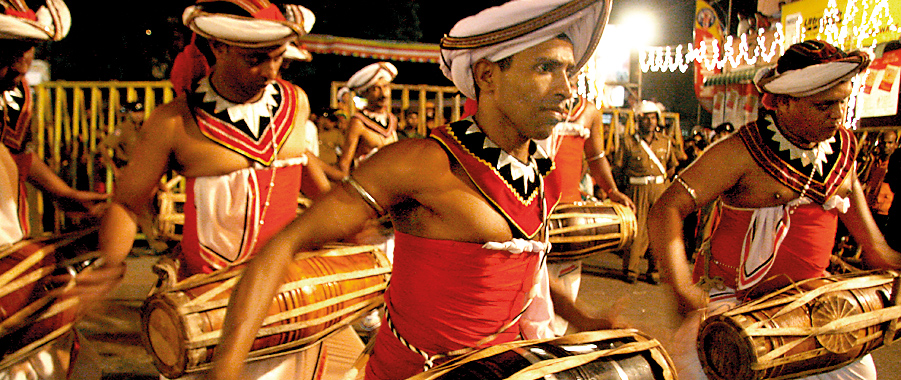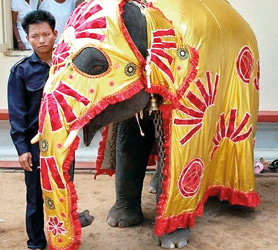Curtain falls on Esala festival with Bellanwila Perahera
View(s):The month of Esala is the festival month. The Sri Dalada Perahera in Kandy tops the list of festivals during August. Large crowds flocked to Kandy for the Randoli Perahera – the most colourful segment last week. The Kataragama festival drew Hindu and Buddhist devotees to the South. The festival month ends with the Randoli Perahera of the annual Bellanwila Esala Perahera on Saturday, August 31.

Is Myankumar, the little elephant from Myanmar going to join the others on his maiden perahera in the streets around Bellanwila this week? The seven-year-old is still not mature enough to march alongside the seniors but may be given a trial run. After all, it will one day carry the relic casket and walk majestically in the annual Bellanwila Perahera, the much looked forward- to Esala pageant in the outskirts of Colombo.
The Nedungamuwa Raja – the tusker from Nedungamuwa will carry the relic casket this year too. The tusker has gained experience by being a participant in the Kandy Esala Perahera for several years. The elephant is, in a way unique, in that its owner, Ayurvedic Dr. Harsha Dharmavijaya does not allow it to be taken about in a truck. The jumbo always walks from one point to the other irrespective of the distance. The owner wants to protect the animal from any possible injuries while bring transported. Now aged 60+ years, Nedungamuwe Raja is today the biggest tusker among those participating in the Kandy Perahera. Eleven feet or more in height, the Mysore tusker is believed to be the tallest in the country.
Just as much as people throng to see the Bellanwila Perahera, there is great sanctity attached to the Bellanwila RajamahaVihara. Titled a ‘RajamahaVihara’ because of the temple receiving royal patronage from the ancient Sinhala monarchs, its beginnings are steeped in myth and mystery. Because of its close proximity to the capital, Kotte, the temple gained recognition in the 15th century and is mentioned in the literary works of the time. King Parakramabahu VI (1412-67 AC) who made Jayavardahanapura(Kotte) his capital gave his patronage to the temple, He built a new palace and a Temple of the Tooth Relic to house the Sri Dalada. He had started festivals connected with the worship of the Sri Dalada in the same grandeur as under the earlier kings.
Literature flourished under King Parakrmabahu VI with the celebrated Sri Rahula shining as a great literary figure. Things changed when the Portuguese administering the area around Colombo after their arrival in 1505, were totally anti-Buddhist and the temples were neglected if not destroyed.
Bellanwila came into the limelight once again in the mid-19th century when Thengodagedera Hamuduruwo residing in a temple at Attidiya is said to have heard the sound of drums when he was going by ferry along a stream towards Pepiliyana. He got down and walked towards the direction from where the sound of drums came. The sound gradually faded away as he approached a place where he found a Bodhi tree. It had later been revealed that the tree was one of the thirty two saplings of the sacred Sri Maha Bodhi in Anuradhapura, thereby gaining much respect.

Too young? Myankumar from Myanmar
In the words of Venerable Dr Bellanwila Wimalaratana Nayaka Thera, Deputy Head of the temple, numerous miraculous events connected with the hallowed Bodhi tree inspire awe and veneration of Buddhists as well as non-Buddhists who turn to Bellanwila for supernatural help and intervention. Devotees are constantly seen around the Bodhi tree offering flowers, pouring water to the tree, and lighting lamps and joss sticks. They make vows to overcome physical and mental worries, and pray for success at examinations and other pursuits.
Bellanwila temple rose to its present glory and grandeur due to the untiring efforts of Venerable Bellanwila Sri Somaratana Nayaka Thera who became head in 1946. Ven Dr. Wimalaratana describes him as “an organiser, an innovator, a leader of foresight, and daring.” He gave a spiritual and moral boost to the devotees in the poor villages around. He organised ‘pinkamas’ to invoke blessings on the people. Villagers, who used to complain of illnesses and their cattle dying due to diseases severely affecting their meagre income, gradually began to feel a change.
“Naturally they felt this was due to some mysterious power, especially the Bodhi-tree and the gods supposed to be residing in the precincts. This belief attracted more and more devotees. Through word of mouth this belief spread far and wide and soon Bellanwila became a household word throughout the country,” Ven Dr Wimalaratana reminisces.
Ven Somaratana developed the temple designing the structure of the complex himself. He designed the Budu-ge based on the Jetavana image house in Polonnaruwa. It is one of the main attractions of the temple today particularly after the recent paintings by Somabandhu Vidyapati who opened a new page in the history of Buddhist paintings in Sri Lanka.
The simple procession started by Ven. Somaratana Thera in 1947 has steadily progressed to become the major cultural pageant that it is today. The present chief incumbent, Ven. Dr.Bellanwila Dhammaratana Nayaka Thera is the senior pupil of the late Ven. Somaratana Thera. He is also the Sanghanayaka of the Kotte chapter of the Siyam Nikaya in Singapore.
comments powered by Disqus

